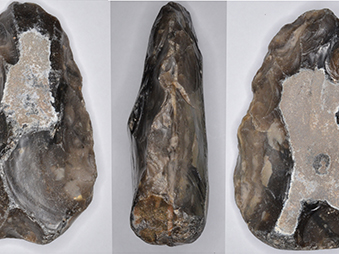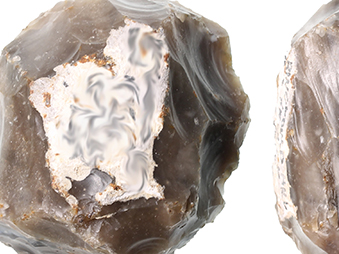Here are a selection of palaeolithc and mesolithic terms used throughout the webpages.
Acheulean
The Acheulean is the name given to Handaxe-based technologies dated to before the Middle Palaeolithic. In Britain it is associated with Homo Heidelbergensis (Pre-Neanderthal) Hominins.
There is much variation in Acheulean styles. But it has been observed that twisted ovate handaxes are possibly dated to MIS 11 and Ficrons and Cleavers with MIS 9.
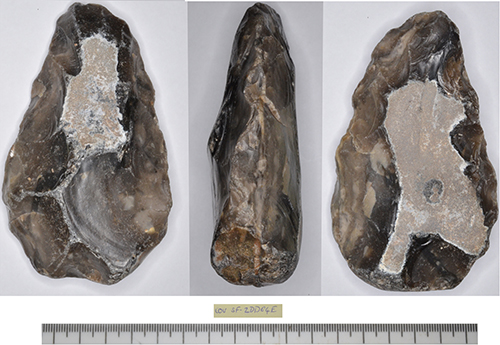
Image: Acheulean Handaxe from Covehithe, HER record COV 173
Anglian Glaciation
The Anglian ice-sheet c. 450,000years ago (MIS 12) covered almost all of Britain, including most of Suffolk. There is no evidence that ice ever reached this far south in Britain at any time before this in previous cold periods and it does not seem likely that ice ever covered Suffolk again. The ice sheet would have been hundreds of metres thick and dammed all the river valleys. This was the time when the River Thames was diverted from its course and eventually settled into its present valley through London. The Bytham River was also destroyed by the Anglian ice sheet. When the ice sheet melted and gradually receded back towards the polar regions, it left behind a thick deposit of Boulder Clay (Lowestoft till) and outwash gravels. Meltwaters drained east and south-east, producing the valleys now occupied by the major rivers of Suffolk: Waveney, Deben, Gipping and Stour.

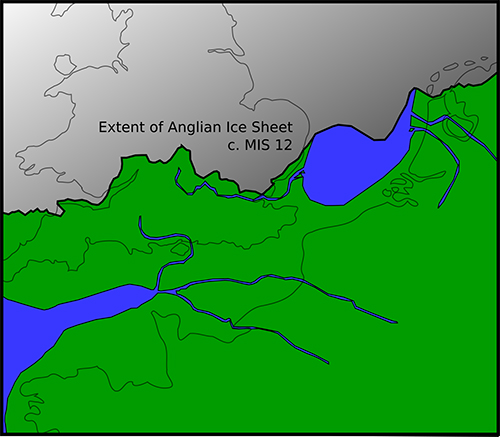
Image (left): The extent of the Anglian Ice Sheet in Suffolk (after Wymer 1999) © Suffolk County Council.
Image (right):The extent of the Anglian Ice Sheet in Suffolk (redrawn after Buteaux et al 2009)
Blade
Flint flake at least twice as long as it is wide.
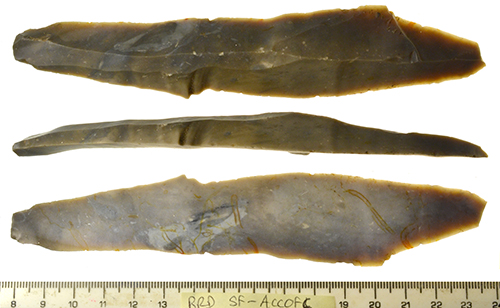
Image: A Long Blade from Brandon, HER record BRD 248
Bout Coupé Handaxe
The term “Bout Coupé” is used to describe a handaxe type peculiar to Britain from the early part of MIS 3 used as a typological marker for the British Late Middle Palaeolithic. The exact definition varies from author to author and even if authors agree on definition, the items which are assigned to the class varies further depending on individual opinion. In general, it is taken to be a cordiform (heart-shaped or like a broad leaf) of small to medium size (when compared to Acheulean handaxes) with straight or slightly convex sides with a sharp break in curvature where the sides meet the flat or slightly curved base. This break in curvature results in noticeable “corners”. While this definition is largely consistent, different names have been proposed or used synonymously named after specific sites.
The term Bout Coupé has until recently been problematic partly because of typological difficulties and differences outlined above but also because it also carried with it specific chronological and cultural implications. The type has successfully been tied to MIS 3 (Mid Devensian) and bar a few uncertain examples it is not related to earlier Lower Palaeolithic sites or contexts or to the now clearly technologically and chronologically defined British Early Middle Palaeolithic.
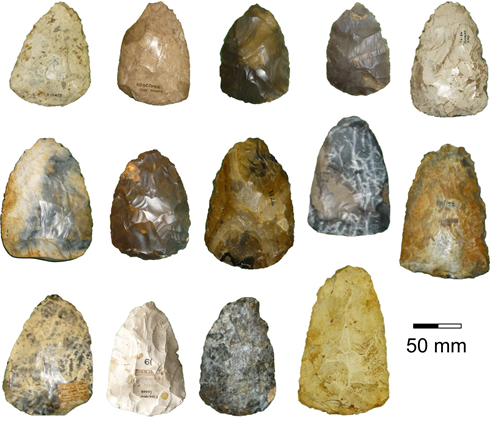
Image: Examples of Bout coupé handaxes from Southern Britain. After Cutler (2013)
BP (before present)
It is common in Early Prehistoric archaeology to use years ago BP (before present); (“present” in this context is 1950).
Clactonian
A British Lower Palaeolithic stone-tool industry characterised by pebble cores, flake tools and an absence of handaxes. It is named after the type site of Clacton-on-Sea, Essex.
Core
The stone nodule or cobble from which flakes are removed. The core preserves the outlines of flake removals and may also show marked hollows.
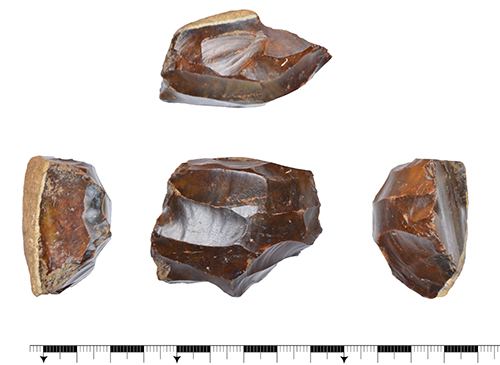
Image: a Mesolithic lithic core from Southolt. Negative scars of removed flakes are visible on the sides.
Doggerland
At various points in the last c. 500,000 years Britain has been a peninsula of Northwest Europe. This is due to sea level height relating to how much water was held in ice caps. Britain was an island c. MIS 5e and MIS 7 and likely in MIS 9 and 11. Depending on sea levels the area of the North Sea would be a low plain, known in the literature as Doggerland. Britain was finally separated from Europe in the Late Mesolithic c. 6,500 BCE.
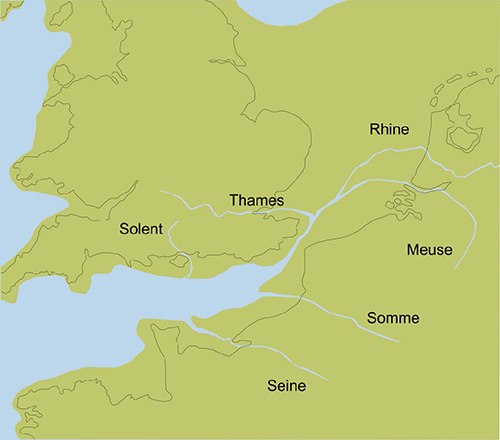
Image: Map of Britain and mainland Europe connected by the Doggerland plain, showing the Channel river system as it may have looked c. 50,000 BP during the time of the last Neanderthals in Britain. (Redrawn after Buteux et al., 2009:41)
Handaxes
Handaxes, are one of the most identifiable Palaeolithic tool types. They are most common in Britain from the Lower Palaeolithic c. 500,000- 300,000 years ago but were also made by Neandertals in Britain c. 60,000-40,000 years ago. Handaxes are stone tools made from nodules or flakes, usually of flint, and are generally worked on both faces with a cutting edge around their circumference. They come in many different forms, such as pointed, ovate and cordate (heart shaped). Many appear inexpertly or quickly fashioned, whereas others are very finely flaked with likelihood of a predetermined shape being imposed on the stone.
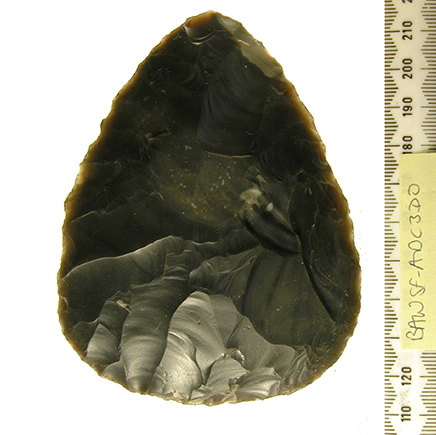
Image: Handaxe from Bawdsey, HER record BAW 157
Last Glacial Maximum
Between c. 31,000 and 16,000 years ago humans were absent from Britain due to the expansion of the British-Irish ice sheet since MIS 4.The ice sheet was smaller than previous ice sheets and did not reach southwards beyond the north Norfolk coast. The periglacial climate at that time caused much contorting of soils, patterned ground caused by ice-wedges, and the sand present in the Breckland region. It was also a time of very low sea-level, c. 60m. or more below the present level of the sea.
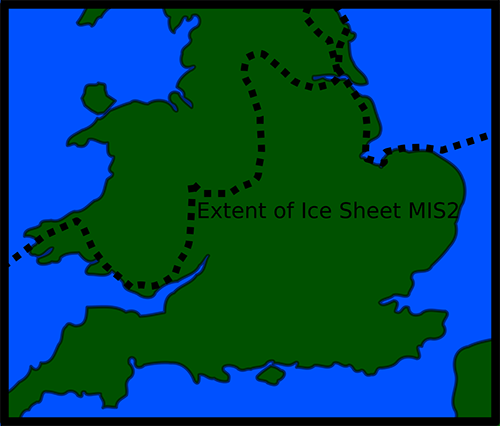
Image: The Dashed line shows the limits of the Devensian (MIS 2) Ice sheet over Britain C. 27 - 17,000 years ago. (based on Clark and Gibbard 2004)
Levallois
Levallois technology is a method of preparing flint cores so that flakes can be knapped in a controlled fashion. They are sometimes called tortoise cores because of their appearance. It became prevalent in the Early Middle Palaeolithic.
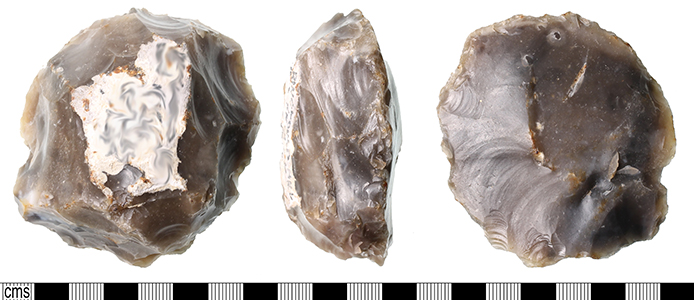
Image: Levallois Core from Kent © Kent County Council
Marine Isotope Stages
Marine Isotope Stages are the chronological framework that is used to describe glacial cycles. They are based on oxygen isotope data which reflect changes in temperature derived from data from deep sea core samples. Odd numbers are warm periods and even numbers are cold periods and as such the lengths of each stage are not equal. The larger the number the further back in time the period. We are currently in MIS 1, the last glaciation c. 20,000 years ago is MIS 2, the Anglian Glaciation c. 450,000 years ago was MIS 12.
The Ancient Human Occupation of Britain Project which ran from 2001 to 2011 funded by the Leverhulme trust produced an easy to understand chart showing the glacial cycle and Marine Isotope Stages, whether Britain was an Island or peninsula, what human species were present and important sites many of which are in Suffolk. View the AHOB Time Chart (PDF).
Mousterian
A Middle Palaeolithic Stone tool industry associated with Neanderthals. Named after the type site of Le Moustier, a rock shelter in the Dordogne, France.
Microlith
Knapped microliths ("small stones") of various types were used throughout the Mesolithic (c. 9000-4000BCE) in Britain. Microliths could be hafted using resin and combined into different tool types to provide longer cutting edges or projectile points.
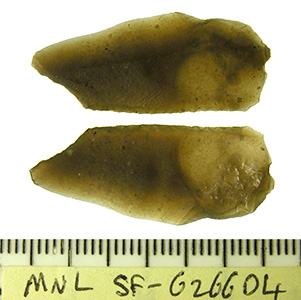
Image: Microlith from Mildenhall, HER record number MNL 1146
Pebble Mace
An important form recognised in association with certain Mesolithic assemblages is the perforated pebble macehead/hammer. These are distinct from more elaborate later prehistoric ‘maceheads’ in that the pebble or stone, invariably a rounded quartzite pebble, is unmodified aside from an axial perforation, generally of hourglass profile.
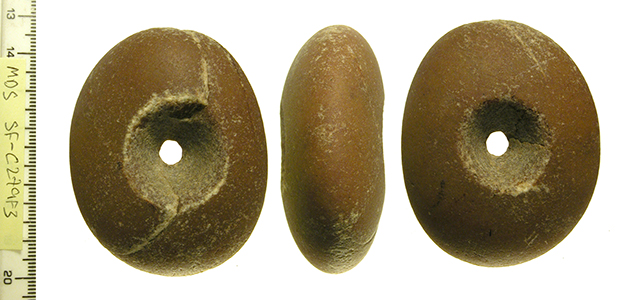
Image: Pebble macehead from Ufford, HER record MDS 246
River Terrace
Remnant of an old floodplain on the side of a valley when a river has cut down through the old floodplain to a lower level. When this process has been repeated several times, this will result in the creation of 'terrace staircase' down the side of the valley with the oldest at the top and youngest at the bottom. Each terrace is typically the creation of a single glacial-interglacial cycle.
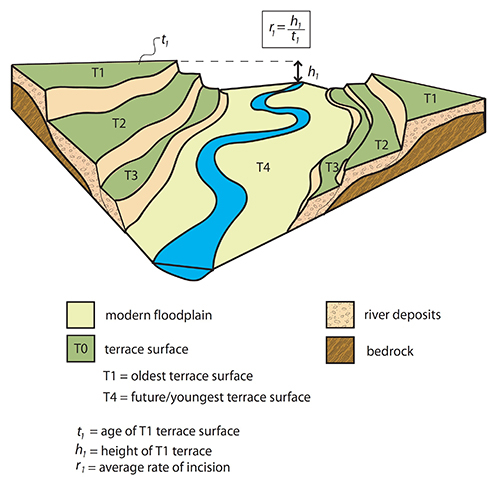
Image: A series of terraces along a river. The oldest terraces (T1) are higher standing than the younger terraces (T3). The present floodplain (T4) will soon become the youngest terrace surface as the river incises. © Sushant Savla (Licensed under the Creative Commons Attribution-Share Alike 4.0 International license).
Tranchet Axehead
In the Mesolithic new flint tool types appear, many of which are related to woodworking, no doubt due to the increased forested environment. Tranchet axeheads are one of the main diagnostic tool types for the Mesolithic in Britain. There is debate as to whether they exclusively represent a strictly Earlier Mesolithic phenomenon, however, they have also been found in several Later Mesolithic contexts.
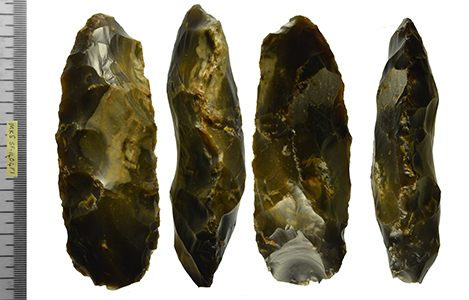
Image: Tranchet axehead from Monk Soham, HER record MKS 016

